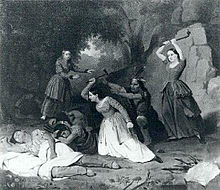Hannah Duston | |
|---|---|
 Hannah Duston Killing the Indians (1847) by Junius Brutus Stearns | |
| Born | Hannah Emerson December 23, 1657 |
| Died | March 6, 1736, 1737 or 1738 Haverhill, Massachusetts |
| Known for | Escaping from captivity |
| Spouse | Thomas Duston Jr. (1652 – c. 1724) |
| Parent(s) | Michael Emerson, Hannah Webster Emerson |
Hannah Duston (also spelled Dustin, Dustan, Durstan, Dustun, Dunstun, or Durstun) (born Hannah Emerson, December 23, 1657 – March 6, 1736,[1] 1737 or 1738[2]) was a colonial Massachusetts Puritan woman who was taken captive by Abenaki people from Quebec during King William's War, with her newborn daughter, during the 1697 raid on Haverhill, in which 27 colonists, 15 of them children, were killed. In her account she stated that the Abenaki killed her baby soon after they were captured. While detained on an island in the Merrimack River in present-day Boscawen, New Hampshire, she killed and scalped ten of the Native American family members holding them hostage, with the assistance of two other captives.
Duston's captivity narrative became famous more than 100 years after she died. During the 19th century, she was referred to as a folk hero and the "mother of the American tradition of scalp-hunting."[3] Some scholars assert Duston's story became legend in the 19th century only because the United States used her story to defend its violence against Native Americans as innocent, defensive, and virtuous.[4] Duston is believed to be the first American woman honored with a statue.[5][6][7][8][9][10]
- ^ H. D. Kilgore, "The Story of Hannah Duston" (June 1940), in Here's Fifty: The First Hundred Years Are the Hardest, Edmund T. Mazur and Garth Clark Dawson. iUniverse, 2008 ISBN 0595527442
- ^ Derounian-Stodola, Kathryn Zabelle (1998). Women's Indian Captivity Narratives. New York: Penguin Classics. p. 55. ISBN 978-0-14-043671-6.
- ^ Grenier, John (2005). The First Way of War. University of Cambridge Press. pp. 40–41.
- ^ Barbara Cutter, "The Female Indian Killer Memorialized: Hannah Duston and the Nineteenth–Century Feminization of American Violence," Journal of Women's History, vol. 20, no. 2, 2008; pp 10–33
- ^ Tauber, Alfred I. (2001). Henry David Thoreau and the Moral Agency of Knowing. Berkeley: Univ. of California Press. p. 241. ISBN 978-0-520-22527-5.
- ^ Robertson, Patrick (2011). Robertson's Book of Firsts: Who Did What for the First Time (1st U.S. ed.). Bloomsbury Publishing USA. ISBN 978-1-60819-738-5.
- ^ Elshtain, Jean Bethke (1987). Women and War. New York: Basic Books. p. 175. ISBN 978-0-465-09216-1.
- ^ Danilov, Victor J. (2005). Women and Museums: A Comprehensive Guide. Lanham, MD; Toronto: AltaMira. p. 63. ISBN 978-0-7591-0855-4.
- ^ Widmer, Mary Lou (1996). Margaret, Friend of Orphans. Gretna, La.: Pelican Pub. Co. p. 123. ISBN 978-1-56554-211-2.
- ^ Faludi, Susan (2013). The Terror Dream: Fear and Fantasy in Post-9/11 America. New York: Henry Holt and Company. p. 313. ISBN 978-1-4299-2212-8.
© MMXXIII Rich X Search. We shall prevail. All rights reserved. Rich X Search
